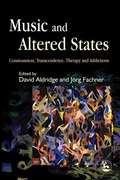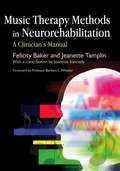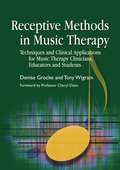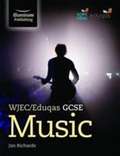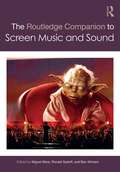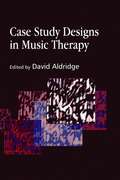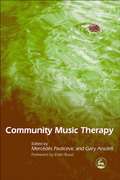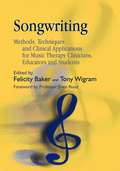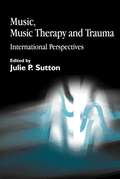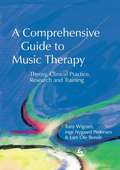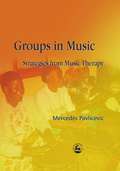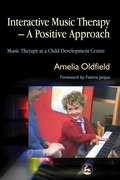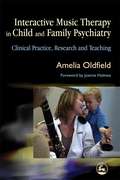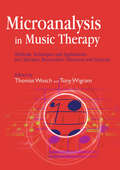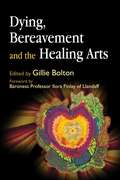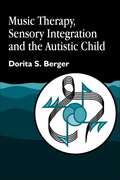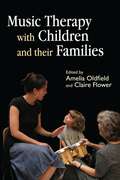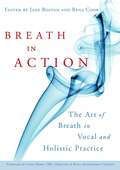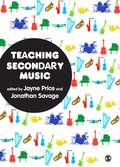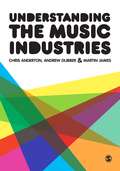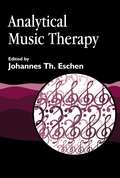- Table View
- List View
Music and Altered States: Consciousness, Transcendence, Therapy and Addictions
by Dalia Cohen David Aldridge Joerg Fachner Lucanne Magill Tsvia HoreshThis international collection examines the opportunities for using music-induced states of altered consciousness to promote physical and mental healing, treat substance dependence, and in spiritual and palliative care. The contributors describe the successful use of altered states and their therapeutic potential, providing examples from different cultures and clinical, therapeutic and spiritual settings. Their observations cover a wide range of music types capable of inducing altered states, including polyrhythmic music, monotonous drumming, Western pop, and Arab musical schemata, complemented by theoretical and clinical approaches to applications in music therapy. This book will be a useful reference for practising music therapists, musicologists, and ethnomusicologists, students and academics in the field.
Music Therapy Methods in Neurorehabilitation: A Clinician's Manual
by Barbara L Wheeler Felicity Baker Jeanette Kennelly Jeanette TamplinThe value of music therapy in neurological rehabilitation is increasingly recognised and this practical manual provides comprehensive guidance for clinicians on the application of music therapy methods in neurorehabilitation. Felicity Baker and Jeanette Tamplin combine research findings with their own clinical experience and present step-by-step instructions and guidelines on how to implement music therapy techniques for a range of therapeutic needs. Photographs clearly illustrate interventions for physical rehabilitation, for example through the use of musical instruments to encourage targeted movement. The chapter on cognitive rehabilitation includes resources and lists suitable songs for use in immediate memory or abstract thinking tasks, among others. In her chapter on paediatric patients, Jeanette Kennelly demonstrates how procedures can be adapted for working clinically with children. A comprehensive list of terminology commonly used in neurological rehabilitation is also included. Music Therapy Methods in Neurorehabilitation will prove an invaluable reference book for music therapy clinicians and students. It is also suitable for work with other populations, in particular for work in special education.
Receptive Methods in Music Therapy: Techniques and Clinical Applications for Music Therapy Clinicians, Educators and Students
by Clare Kildea Denise Grocke Emily Shanahan Karen Hamlett Karin Schou Katerina Stathis Katrina Mcferran Matt Holmes Melina Roberts Susan B Wesely Tony WigramThis practical book describes the specific use of receptive (listening) methods and techniques in music therapy clinical practice and research, including relaxation with music for children and adults, the use of visualisation and imagery, music and collage, song-lyric discussion, vibroacoustic applications, music and movement techniques, and other forms of aesthetic listening to music. The authors explain these receptive methods of intervention using a format that enables practitioners to apply them in practice and make informed choices about music suitable for each of the different techniques. Protocols are described step-by-step, with reference to the necessary environment, conditions, skills and appropriate musical material. Receptive Methods in Music Therapy will prove indispensable to music therapy students, practitioners, educators and researchers.
WJEC/Eduqas GCSE Music (PDF)
by Jan RichardsThis book is designed to help with the WJEC/Eduqas GCSE Music course. It is divided into five sections: one section on each of the four areas of study.
The Routledge Companion To Screen Music And Sound
by Miguel Mera Ron Sadoff Benjamin WintersThe Routledge Companion to Screen Music and Sound provides a detailed and comprehensive overview of screen music and sound studies, addressing the ways in which music and sound interact with forms of narrative media such as television, videogames, and film. The inclusive framework of "screen music and sound" allows readers to explore the intersections and connections between various types of media and music and sound, reflecting the current state of scholarship and the future of the field. A diverse range of international scholars have contributed an impressive set of forty-six chapters that move from foundational knowledge to cutting edge topics that highlight new key areas. The companion is thematically organized into five cohesive areas of study: Issues in the Study of Screen Music and Sound#65533;discusses the essential topics of the discipline Historical Approaches#65533;examines periods of historical change or transition Production and Process#65533;focuses on issues of collaboration, institutional politics, and the impact of technology and industrial practices Cultural and Aesthetic Perspectives#65533;contextualizes an aesthetic approach within a wider framework of cultural knowledge Analyses and Methodologies#65533;explores potential methodologies for interrogating screen music and sound Covering a wide range of topic areas drawn from musicology, sound studies, and media studies, The Routledge Companion to Screen Music and Sound provides researchers and students with an effective overview of music#65533;s role in narrative media, as well as new methodological and aesthetic insights.
The Routledge Companion To Screen Music And Sound (PDF)
by Miguel Mera Ron Sadoff Benjamin WintersThe Routledge Companion to Screen Music and Sound provides a detailed and comprehensive overview of screen music and sound studies, addressing the ways in which music and sound interact with forms of narrative media such as television, videogames, and film. The inclusive framework of "screen music and sound" allows readers to explore the intersections and connections between various types of media and music and sound, reflecting the current state of scholarship and the future of the field. A diverse range of international scholars have contributed an impressive set of forty-six chapters that move from foundational knowledge to cutting edge topics that highlight new key areas. The companion is thematically organized into five cohesive areas of study: Issues in the Study of Screen Music and Sound--discusses the essential topics of the discipline Historical Approaches--examines periods of historical change or transition Production and Process--focuses on issues of collaboration, institutional politics, and the impact of technology and industrial practices Cultural and Aesthetic Perspectives--contextualizes an aesthetic approach within a wider framework of cultural knowledge Analyses and Methodologies--explores potential methodologies for interrogating screen music and sound Covering a wide range of topic areas drawn from musicology, sound studies, and media studies, The Routledge Companion to Screen Music and Soundprovides researchers and students with an effective overview of music's role in narrative media, as well as new methodological and aesthetic insights.
Case Study Designs in Music Therapy
by Denise Grocke Cochavit Elefant David Aldridge Hanne Mette Ridder Ochsner Gudrun AldridgeResearch and clinical work are often perceived as opposites in the field of music therapy. This book shows, for the first time, how these two areas of work can creatively complement one another, proving beneficial to both disciplines. Each chapter is written by a leading researcher and practitioner in the field, and the book covers a wide spectrum of approaches within different settings. Beginning with methodological and musicological approaches to case studies, the book then moves on to more specific topics such as the use of case studies in an interactive play setting and in music therapy with the elderly. Later chapters explore theoretical aspects, looking at a worked example of music and progressive change during therapy, and how case study designs can be used in practice. A must for all professionals working and studying within the music therapy area, this is also an informative and useful book for health researchers.
Community Music Therapy
by Mercedes Pavlicevic Gary AnsdellMusic therapists from around the world working in conventional and unconventional settings have offered their contributions to this exciting new book, presenting spirited discussion and practical examples of the ways music therapy can reflect and encourage social change. From working with traumatized refugees in Berlin, care-workers and HIV/AIDS orphans in South Africa, to adults with neurological disabilities in south-east England and children in paediatric hospitals in Norway, the contributors present their global perspectives on finding new ways forward in music therapy. Reflecting on traditional approaches in addition to these newer practices, the writers offer fresh perceptions on their identity and role as music therapists, their assumptions and attitudes about how music, people and context interact, the sites and boundaries to their work, and the new possibilities for music therapy in the 21st century. As the first book on the emerging area of Community Music Therapy, this book should be an essential and exciting read for music therapists, specialists and community musicians.
Songwriting: Methods, Techniques and Clinical Applications for Music Therapy Clinicians, Educators and Students
by Emma Davies Tony Wigram Lucanne Magill Jeanette Kennelly Felicity Baker Jeanette Tamplin Amelia OldfieldThis comprehensive and groundbreaking book describes the effective use of songwriting in music therapy with a variety of client populations, from children with cancer and adolescents in secondary school to people with traumatic brain injury and mental health problems. The authors explain the specific considerations to bear in mind when working with particular client groups to achieve the best clinical outcomes. All the contributors are experienced music therapy clinicians and researchers. They provide many case examples from clinical practice to illustrate the therapeutic methods being used, together with notated examples of songs produced in therapy. Particular emphasis is placed on how lyrics and music are created, including the theoretical approaches underpinning this process. This practical book will prove indispensable to students, clinical therapists, music therapists, educators, teachers and musicians.
Music, Music Therapy and Trauma: International Perspectives
by Diane Snow Austin Julie SuttonMusic communicates where words fail, and music therapy has been proven to connect with those who were thought to be unreachable, making it an ideal medium for working with those who have suffered psychological trauma. Music, Music Therapy and Trauma addresses the need for an exploration of current thinking on music and trauma. With chapters written by many of today's leading specialists in this area, music and trauma is approached from a wide range of perspectives, with contributions on the following: * neurology of trauma and music; * music and trauma in general; * social and cultural perspectives on trauma; * contextualising contemporary classical music and conflict; * music and trauma in areas where there is war, community unrest and violence (Northern Ireland, Bosnia-Herzegovina, South Africa); * music, trauma and early development. Including specific examples and case studies, this book addresses the growing interest in the effects of trauma and how music therapy can provide a way through this complex process.
A Comprehensive Guide to Music Therapy: Theory, Clinical Practice, Research and Training
by Tony Wigram Lars Ole BondeMusic therapists, as in medical and paramedical professions, have a rich diversity of approaches and methods, often developed with specific relevance to meet the needs of a certain client population. This book reflects the many components of such diversity, and is a thoroughly comprehensive guide to accessing and understanding the ideas, theory, research results and clinical outcomes that are the foundations of this field. Providing a detailed insight into the field of music therapy from an international perspective, this book enables the reader to see the complete picture of the multifaceted and fascinating world that is music therapy.
Groups in Music: Strategies from Music Therapy
by Mercedes PavlicevicMusic in Groups happens all the time: in the street, the classroom, in music colleges, community centres, hospitals, prisons, churches and concert halls; at raves, weddings, music festivals, public ceremonies, music therapy sessions, group music lessons, concerts and rehearsals. Some group musicking seems to 'work' (and play) better than others; some sessions feel exhausting even if things are going well; and at other times, we can't begin to explain the complex musical and relational textures of group music work to funders, employers, friends, colleagues, or line managers. In this book, music therapist Mercédès Pavlicevic develops a broad-based discourse to describe, analyse and guide the practice of group musicking, drawing on her own extensive experience. The text is illustrated with vignettes drawn from a range of formal and informal settings that include spontaneous public occasions, collective rituals, special and mainstream education, music therapy, the concert hall, the music appreciation group and community work. This book makes you think about balancing individual and group needs, the development of group time, dealing with over-enthusiastic performers who 'hog' the group sound, undercurrents in music groups, the complications of dealing with institutions, preparing music listening programmes and buying instruments for group work - if you're involved in any kind of group musicking, this book is for you.
Interactive Music Therapy - A Positive Approach: Music Therapy at a Child Development Centre
by Fatima Janjua Amelia OldfieldIn Interactive Music Therapy - A Positive Approach, Amelia Oldfield explains how her approach to music therapy sessions establishes a constructive musical dialogue with children that emphasises positive experiences - these establish trust and allow feelings to be expressed through music. Describing the general benefits of this approach, the author also details its application for specific clinical groups including children with autistic spectrum disorders, relationship difficulties or physical disabilities. Individual chapters focus specifically on child development issues and in child and brief case studies throughout the text illustrate points of particular importance. This practical book will be of use to other clinicians and teachers working with children with a variety of needs, including children on the autism spectrum and children with learning disabilities. It is also of use to music therapy trainers, their students and academics whose interests include music therapy.
Interactive Music Therapy in Child and Family Psychiatry: Clinical Practice, Research and Teaching
by Jo Holmes Amelia Oldfield'What is truly distinctive about this book is that Oldfield introduces her doctoral research, in which she created the Music Therapy Diagnostic Assessment (MTDA) in comparison to one of the most internationally recognized standardized diagnostic tool.' - Autism Diagnostic Observation Schedule (ADOS). 'I believe that the book will be useful for music therapy students, and novice music therapist working in child and family psychiatry and related fields.' - Nordic Journal of Music Therapy 'In her indomitable, accessible and straightforward style, Amelia Oldfield continues to champion the use of music therapy with families in her most recent publication. The book is in many ways a step-by-step music therapy manual, informing us of music therapy methods and innovations and provoking new thoughtfulness for work within the child mental health setting.' - Journal of Family Therapy 'This book could be an invaluable resource for readers who are looking for evidence that music therapy can have a very positive effect on certain disorders and family dynamics. I could imagine it would bring great hope for those whose children find communication very difficult, or where families are struggling to relate emotionally. The book [also] has a lot of clinical research data, which would be extremely useful for students or clinicians needing to validate this kind of work.' - ACCord Magazine 'This practical book outlines and explains the rationale for using music therapy in child and family psychiatry. Amelia Oldfield reflects on current research methodology and describes characteristics of her own approach to therapy sessions, including how to start and end the session, how to motivate children and establish a positive musical dialogue with them, and how to include parents in the session. She also uses video analysis techniques to assess and advance the role of the therapist. Individual chapters focus on the results of the author's research investigations with specific groups such as mothers and young children, groups of adults with profound difficulties, children with autistic spectrum disorder or severe physical and mental difficulties, as well as children without clear diagnosis. Case studies and vignettes supplement these examples. The author also considers the whole process from the initial referral for therapy and using psychiatric music therapy for diagnostic assessment to how to end treatment. This book is accessible to music therapists, psychiatrists, nurses and occupational therapists working with children and families, as well as music therapy trainers, their students and academics interested in music therapy.' - British Society for Music Therapy 'Those who are specifically interested in music therapy as applied to children and families will find no better mentor than Oldfield.' - Mental Health Care Practice 'Well, this book was a pleasant surprise! I found it a remarkably uplifting read. Amelia Oldfield describes in detail how she has managed to interact through music with children (and adults) with a wide range of significant difficulties, intellectual, emotional and physical. Her music therapy is intended to help with diagnosis but she also involved parents and carers in her sessions in a way which helps them to come to terms with and deal more comfortably with their charges.' - Adoption.net This practical book outlines and explains the rationale for using music therapy in child and family psychiatry. Amelia Oldfield reflects on current research methodology and describes characteristics of her own approach to therapy sessions, including how to start and end the session, how to motivate children and establish a positive musical dialogue with them, and how to include parents in the session. She also uses video analysis techniques to assess and advance the role of the therapist. Individual chapters focus on the results of the author's research investigations with specific groups such as mothers and young children, groups of adults with profound difficulties, children with autistic spectrum disorder or severe phy...
Microanalysis in Music Therapy: Methods, Techniques and Applications for Clinicians, Researchers, Educators and Students
by Tony Wigram Barbara L Wheeler Thomas WoschIn the context of music therapy, microanalysis is the detailed analysis of that short period of time during a music therapy session during which some kind of significant change takes place. These moments are crucial to the therapeutic process, and there is increasing interest amongst music therapists in understanding how they come about and whether there are ways of initiating them. The contributors to this groundbreaking book look at methods of micro process analyses used in a variety of music therapy contexts, both clinical and research-based. They outline their methods, which include using video and audio materials, interviewing, and monitoring the client's heart rate, and also give examples of the practical application of microanalysis from their clinical experience, including work with clients who have psychiatric illness, autism and other conditions. Microanalyses in Music Therapy provides a wealth of important theoretical and practical information for music therapy clinicians, educators and students.
Dying, Bereavement and the Healing Arts
by David Head John Graham-Pole Diana Greenman Sandra Bertman Kaichiro Tamba Mark Cobb Tim Jeeves Ted Bowman Sheelagh Gallagher River Wolton Rogan Wolf Giles Legood Chris Rawlence Tim Metcalf Yvonne Yi-Wood Mak Haifa Al Sanousi Paul Schatzberger Corine Koppenol Robert Hamberger Kate D'Lima Amy Kuebelbeck Oliver Samuel Julie Sanders Gillie Bolton Frans Meulenberg Monica Suswin Sue Eckstein Nigel Hartley Sinead Donnelly Judy Clinton Kieran Walsh Filipa Pereira-Stubbs Anna Lidzey Mike White Bobbie Farsides Steve Seagull Christopher Johns Christina Mason Ashley Barnes Mitzi Blennerhassett Lesley Schatzberger Lindsay Buckell Hilary ElfickDying, Bereavement and the Healing Arts describes a range of successful programmes pioneered by artists, writers, nurses, musicians, therapists, social workers, and chaplains in palliative care settings. These range from simple painting and writing activities to organized communal activities like writing and performing a play. The arts are shown to offer a means to reflect on memories, hopes, fears and anxieties, and gently explore the emotional, spiritual, and psychological issues which can aid a fuller understanding of oneself and one's condition. The arts also serve as a way to communicate difficult and complex feelings to professionals or family members not possible in everyday conversation. Dying, Bereavement and the Healing Arts offers valuable insights and inspiration for any practitioner working in a palliative care setting.
Music Therapy, Sensory Integration and the Autistic Child
by Dorita S. BergerMusic's ability to influence emotions and moods is universally acknowledged, and music therapists have long known that stimulating the brain through the auditory system is a key to obtaining remarkable responses. Music therapy is a particularly effective tool when working with children with autism spectrum conditions, because music communicates with these children on a level where mere words cannot go. Written in a way that is both informative for the professional and accessible for parents, this book furthers the already strong case for the use of music therapy as a resource to encourage behavioural changes for the better in children with autism spectrum conditions. Placing particular emphasis upon sensory integration, the author discusses contributing factors to the behaviour of people on the autism spectrum, and, through the use of case studies, presents the latest approaches in music therapy that are enabling children with autism spectrum conditions to better cope with sensory integration.
Music Therapy with Children and their Families
by Tiffany Hughes Emma Davies Vince Hesketh Rachel Bull Nicky O'Neill Joy Hasler Kay Sobey Sarah Russel Helen Loth Claire Flower Jassenka Horvat Colette Salkeld Amelia OldfieldIn the past, music therapy work with children typically took place in special schools without the family being present. More recently, music therapy has become a widespread practice, and this book reflects the variety of settings within which music therapists are now working with children together with their families. The contributors are music therapists with experience of working with children and their families in a range of different environments, such as schools, hospices, psychiatric units, child development centres and in the community. They describe their approaches to family work with client groups including children with autism, learning disabled toddlers, adopted children and looked after teenagers. Their experiences demonstrate that involving the family in a child's music therapy can be beneficial for everyone, and that it is possible to address relationship issues within the family as part of the treatment. This book will provide useful insight into the growing area of music therapy with children and their families, and will be valuable for music therapy professionals and students, as well as other medical and teaching professionals who work with families.
Breath in Action: The Art of Breath in Vocal and Holistic Practice
by Roger Smart David Carey Rebecca Cuthbertson Stephanie Martin Rocco Dal Vera Rena Cook Joanna Weir Ouston Katya Bloom Jane Boston Judy Lee Vivier Gillyanne Kayes Marj Mcdaid Kristin Linklater Yolanda Heman-Ackah April Pierrot Lisa Wilson Mel Churcher Cicely Berry Tara Mcallister-Viel Debbie Green Michael Morgan Jessica Wolf Floyd KennedyBreath in Action looks at the significance of breath to human life - not just the simple fact that if we stop breathing, we die, but also the more subtle ways in which our breath interacts with our voice and our being. Written by experts in vocal and holistic practice, the book is divided into four sections: Breath and the Body; Breath and the Mind; Breath and Holistic Practice; Breath and Performance. It offers the latest theories from a variety of disciplines on how we can be taught to breathe better so as to communicate better, act or sing better, feel better, live better. Combining theory with practice, many of the chapters also offer clearly laid out breathing exercises and techniques. Interdisciplinary in its focus, Breath in Action adds to specialist knowledge in the performance field, whilst also offering enlightening information for those interested in therapeutic and healing processes, movement, and voice and speech sciences.
Teaching Secondary Music
by Jayne Price Jonathan SavageDesigned to support teachers in developing new strategies and pedagogies for teaching music, and for teacher education students requiring a comprehensive overview of the subject Teaching Secondary Music provides a modern and accessible insight into the key issues in music education at secondary level. Focusing on the nature of musical understanding and how to facilitate and assess musical progress, the editors bring together a team of experienced music educators leading the programme of support for the new secondary curriculum. Supported with practical examples, case studies and resources exploring effective practice, Teaching Secondary Music covers the key concepts and approaches which underpin good practice in secondary music education. These include: -How music relates to other curriculum subjects -Ways of implementing newer aspects of the curriculum -The music industry and intellectual property rights -Working with a range of musicians -Using ICT as a tool for musical performance -Developing musical leadership This book is essential reading for PGCE Secondary music specialists and practising music teachers. Jayne Price is the Music Education Coordinator in the School of Education and Professional Development at the University of Huddersfield. Jonathan Savage is a Reader in Education at the Institute of Education, Manchester Metropolitan University.
Understanding the Music Industries (PDF)
by Andrew Dubber Chris Anderton Martin JamesEveryone knows music is big business, but do you really understand how ideas and inspiration become songs, products, downloads, concerts and careers? This textbook guides students to a full understanding of the processes that drive the music industries. More than just an expose or 'how to' guide, this book gives students the tools to make sense of technological change, socio-cultural processes, and the constantly shifting music business environment, putting them in the front line of innovation and entrepreneurship in the future. Packed with case studies, this book: • Takes the reader on a journey from Glastonbury and the X-Factor to house concerts and crowd-funded releases; • Demystifies management, publishing and recording contracts, and the world of copyright, intellectual property and music piracy; • Explains how digital technologies have changed almost all aspects of music making, performing, promotion and consumption; • Explores all levels of the music industries, from micro-independent businesses to corporate conglomerates; • Enables students to meet the challenge of the transforming music industries. This is the must-have primer for understanding and getting ahead in the music industries. It is essential reading for students of popular music in media studies, sociology and musicology.
Analytical Music Therapy (PDF)
by Johannes Eschen Juliane Kowski Susan HadleyThis book brings together the professional experiences of eminent analytical music therapists from Europe and the USA. The book examines the origins and theory of AMT (including a contribution on the subject from Mary Priestley), before exploring its uses in various contexts. Chapters cover AMT in counselling and rehabilitation, with adults and children and with nonverbal clients. A concluding section discusses aspects of the training of music therapy students. Written by experienced and highly regarded analytic music therapists, and edited by Johannes Th. Eschen, one of the first ever AMT students, this book will be of interest to practitioners in many branches of music therapy and related disciplines.
Breath in Action: The Art of Breath in Vocal and Holistic Practice (PDF)
by April Pierrot Cicely Berry David Carey Debbie Green Floyd Kennedy Gillyanne Kayes Jane Boston Jessica Wolf Joanna Weir Ouston Judy Lee Vivier Katya Bloom Kristin Linklater Lisa Wilson Marj Mcdaid Mel Churcher Michael Morgan Rebecca Cuthbertson Rena Cook Rocco Dal Vera Roger Smart Stephanie Martin Tara Mcallister-Viel Yolanda Heman-AckahBreath in Action looks at the significance of breath to human life - not just the simple fact that if we stop breathing, we die, but also the more subtle ways in which our breath interacts with our voice and our being. Written by experts in vocal and holistic practice, the book is divided into four sections: Breath and the Body; Breath and the Mind; Breath and Holistic Practice; Breath and Performance. It offers the latest theories from a variety of disciplines on how we can be taught to breathe better so as to communicate better, act or sing better, feel better, live better. Combining theory with practice, many of the chapters also offer clearly laid out breathing exercises and techniques. Interdisciplinary in its focus, Breath in Action adds to specialist knowledge in the performance field, whilst also offering enlightening information for those interested in therapeutic and healing processes, movement, and voice and speech sciences.
Case Study Designs in Music Therapy (PDF)
by Cochavit Elefant David Aldridge Denise Grocke Gudrun Aldridge Hanne Mette Ridder Ochsner Tony WigramResearch and clinical work are often perceived as opposites in the field of music therapy. This book shows, for the first time, how these two areas of work can creatively complement one another, proving beneficial to both disciplines. Each chapter is written by a leading researcher and practitioner in the field, and the book covers a wide spectrum of approaches within different settings. Beginning with methodological and musicological approaches to case studies, the book then moves on to more specific topics such as the use of case studies in an interactive play setting and in music therapy with the elderly. Later chapters explore theoretical aspects, looking at a worked example of music and progressive change during therapy, and how case study designs can be used in practice. A must for all professionals working and studying within the music therapy area, this is also an informative and useful book for health researchers.
Community Music Therapy (PDF)
by Gary Ansdell Mercedes PavlicevicMusic therapists from around the world working in conventional and unconventional settings have offered their contributions to this exciting new book, presenting spirited discussion and practical examples of the ways music therapy can reflect and encourage social change. From working with traumatized refugees in Berlin, care-workers and HIV/AIDS orphans in South Africa, to adults with neurological disabilities in south-east England and children in paediatric hospitals in Norway, the contributors present their global perspectives on finding new ways forward in music therapy. Reflecting on traditional approaches in addition to these newer practices, the writers offer fresh perceptions on their identity and role as music therapists, their assumptions and attitudes about how music, people and context interact, the sites and boundaries to their work, and the new possibilities for music therapy in the 21st century. As the first book on the emerging area of Community Music Therapy, this book should be an essential and exciting read for music therapists, specialists and community musicians.
